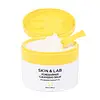What's inside
What's inside
 Key Ingredients
Key Ingredients

 Benefits
Benefits

 Concerns
Concerns

 Ingredients Side-by-side
Ingredients Side-by-side

Ethylhexyl Palmitate
EmollientPEG-20 Glyceryl Triisostearate
EmollientIsododecane
EmollientHydrogenated Poly(C6-14 Olefin)
EmollientSynthetic Wax
AbrasivePEG-10 Isostearate
EmulsifyingSilica Dimethyl Silylate
EmollientParfum
MaskingOlea Europaea Fruit Oil
MaskingCentella Asiatica Leaf Extract
Skin ConditioningGlyceryl Stearate
EmollientWater
Skin ConditioningSimmondsia Chinensis Seed Oil
EmollientPolyglyceryl-3 Polyricinoleate
EmulsifyingGardenia Florida Fruit Extract
Skin ConditioningCarthamus Tinctorius Flower Extract
Skin ConditioningButylene Glycol
HumectantCoptis Japonica Extract
AntimicrobialGlycerin
Humectant1,2-Hexanediol
Skin ConditioningDipropylene Glycol
HumectantPolyglyceryl-10 Oleate
Skin ConditioningCentella Asiatica Root Extract
Skin ConditioningCentella Asiatica Extract
CleansingPentylene Glycol
Skin ConditioningMadecassoside
AntioxidantCapryloyl Salicylic Acid
Exfoliating4-Terpineol
MaskingPrunus Amygdalus Dulcis Oil
Skin ConditioningPropanediol
SolventAsiatic Acid
Skin ConditioningMadecassic Acid
Skin ConditioningAsiaticoside
AntioxidantChamomilla Recutita Flower Oil
MaskingIndigofera Tinctoria Extract
MaskingCynanchum Atratum Extract
Skin ConditioningHemerocallis Fulva Flower Extract
Skin ConditioningMyosotis Sylvatica Flower/Leaf/Stem Extract
Skin ConditioningHydroxycinnamic Acid
Skin ConditioningRutin
AntioxidantEthylhexyl Palmitate, PEG-20 Glyceryl Triisostearate, Isododecane, Hydrogenated Poly(C6-14 Olefin), Synthetic Wax, PEG-10 Isostearate, Silica Dimethyl Silylate, Parfum, Olea Europaea Fruit Oil, Centella Asiatica Leaf Extract, Glyceryl Stearate, Water, Simmondsia Chinensis Seed Oil, Polyglyceryl-3 Polyricinoleate, Gardenia Florida Fruit Extract, Carthamus Tinctorius Flower Extract, Butylene Glycol, Coptis Japonica Extract, Glycerin, 1,2-Hexanediol, Dipropylene Glycol, Polyglyceryl-10 Oleate, Centella Asiatica Root Extract, Centella Asiatica Extract, Pentylene Glycol, Madecassoside, Capryloyl Salicylic Acid, 4-Terpineol, Prunus Amygdalus Dulcis Oil, Propanediol, Asiatic Acid, Madecassic Acid, Asiaticoside, Chamomilla Recutita Flower Oil, Indigofera Tinctoria Extract, Cynanchum Atratum Extract, Hemerocallis Fulva Flower Extract, Myosotis Sylvatica Flower/Leaf/Stem Extract, Hydroxycinnamic Acid, Rutin
Ingredients Explained
These ingredients are found in both products.
Ingredients higher up in an ingredient list are typically present in a larger amount.
Capryloyl Salicylic Acid comes from salicylic acid, the famous acne-fighting BHA.
It usually goes by a more common name of LHA, or lipohydroxy acid.
Like salicylic acid, this ingredient is a chemical exfoliant that can help break down the oil in your pores and reduce inflammation.
Though studies for LHA do show it to be less effective than salicylic acid. To be fair, salicylic acid is the reigning monarch of acne treatments.
However, a study from 2009 found LHA to be comparable to BPO, making it a good alternative for people with sensitive skin. Another study of 14 patients found a significant decrease in comedones after using LHA.
Another pro of LHA? It is less irritating than salicylic acid due to its large molecule size.
Large molecules cannot penetrate skin as well, so they are gentler on the skin. LHA is much less penetrative than salicylic acid.
An in-vitro study (not done on a living organism) found only 6% of LHA penetrated past the statum corneum compared to 58% of salicylic acid. An in-vivo (done on a living organism) analysis revealed ~17% of LHA was still present in the top layer of skin after 4 days, versus ~9% of salicylic acid.
Interestingly, a study from 2008 found LHA comparable to another famous acid, glycolic acid.
This study found about 10% of LHA is as effective as 20-50% of glycolic acid in treating hyperpigmentation and fine-lines.
Hydroxy acids have been found to stimulate skin protein, lipids, and thermal thickening. This may have anti-aging benefits.
Learn more about Capryloyl Salicylic AcidParfum is a catch-all term for an ingredient or more that is used to give a scent to products.
Also called "fragrance", this ingredient can be a blend of hundreds of chemicals or plant oils. This means every product with "fragrance" or "parfum" in the ingredients list is a different mixture.
For instance, Habanolide is a proprietary trade name for a specific aroma chemical. When used as a fragrance ingredient in cosmetics, most aroma chemicals fall under the broad labeling category of “FRAGRANCE” or “PARFUM” according to EU and US regulations.
The term 'parfum' or 'fragrance' is not regulated in many countries. In many cases, it is up to the brand to define this term.
For instance, many brands choose to label themselves as "fragrance-free" because they are not using synthetic fragrances. However, their products may still contain ingredients such as essential oils that are considered a fragrance by INCI standards.
One example is Calendula flower extract. Calendula is an essential oil that still imparts a scent or 'fragrance'.
Depending on the blend, the ingredients in the mixture can cause allergies and sensitivities on the skin. Some ingredients that are known EU allergens include linalool and citronellol.
Parfum can also be used to mask or cover an unpleasant scent.
The bottom line is: not all fragrances/parfum/ingredients are created equally. If you are worried about fragrances, we recommend taking a closer look at an ingredient. And of course, we always recommend speaking with a professional.
Learn more about ParfumPEG-10 Isostearate isn't fungal acne safe.
Peg-20 Glyceryl Triisostearate comes from Isostearic Acid and glycerin.
It is an emollient, emulsifier, and gentle cleanser. As an emollient, it helps trap moisture to keep skin soft and hydrated. Emulsifiers help prevent ingredients from separating.
This ingredient is common in oil-based products. This is because it helps oil-ingredients be easily washed away without leaving a residue.
Peg-20 Glyceryl Triisostearate may not be fungal-acne safe.
Learn more about PEG-20 Glyceryl TriisostearateSynthetic Wax is created from fossil fuels such as natural gas. It is used to enhance texture, adjust pH, and as an occlusive.
It may also be used as an abrasive ingredient to exfoliate the skin.
Synthetic Wax may not be fungal acne safe.
Learn more about Synthetic Wax